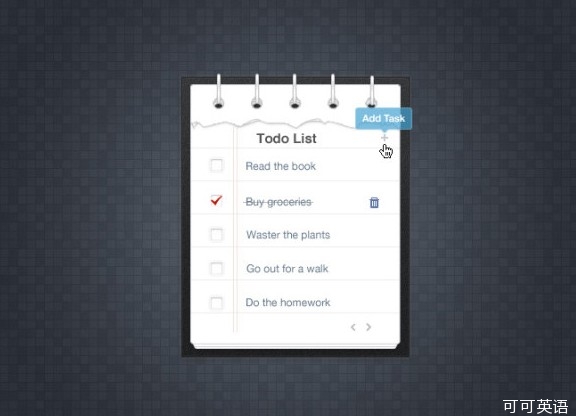
Have you ever written a to-do list, only to find that, at the end of the day, you hadn’t even managed one item on it?
你是否曾经写过任务清单,然后到头来发现到清单上面一件事也没做?
When you fail to make headway with your to-do list, you might end up blaming yourself – but it’s probably not your fault.
当你的任务清单毫无进度,你便责骂自己,但是这可能不是你的原因。
To-do lists are great tools, but to be truly effective, you need to know a few tricks for making them work well.
任务清单是一个伟大的生活工具,可是想要让其生效,你需要一些技巧把清单做得头头是道。
1: Write Action Items
1. 写出动词部分
Does your to-do list look like this?
你的任务清单是这样写的?
New desk?
新桌子?
Bob and Jane
鲍伯和珍
While you might know exactly what these mean in the context of your day, there’s also a good chance you’ve not really pinned down each task.
虽然你可能会准确地知道这些在你的清单中的意思,但这种写法很可能让你松懈,不强行自己完成每一个任务。
After all, you’re unlikely to sit down and get all your taxes completely done in one session – and when you see “taxes” on the list, your first response is probably to jump straight to the next item.
毕竟,你不可能坐下来,把关于税收的写成一段话,然而,当你看到写着“税”的单子,你的第一反应很可能是直接跳过去浏览下一个项目。
A really effective to-do list uses action items. That means starting each task with a verb, and being specific about what you’re going to do:
一个真正有效的任务清单是会写出操作项目。也就是每一个任务是以动词开始的,并且要详细到你要干嘛。
Check tax deadline, and sort all receipts into date order.
检查纳税期限,根据日期顺序整理所有收据。
Look into the top three options for a new desk.
去家具店买一把新桌子。
Call Bob and Jane to confirm dinner this weekend.
给鲍勃和简打电话确认本周末的晚餐.
2: Break Big Projects into Smaller Tasks2.
2. 把大项目分成小任务
Sometimes, a vague item is a big project that needs breaking into smaller tasks. “Write report” often isn’t something you can easily get your head around – but “get data for section 1 of report” is.
有时候,一个模糊的任务是一个大项目,需要分成一个个小的任务。“写报告”往往是让你没有头绪的东西,但是让你“找到报告第一部分的资料”就会让你很明了。
By breaking up any big projects into smaller tasks, you make your to-do list much more valuable. Once you actually get going on those tasks, you’ll already have done some of the high-level thinking – and you can check them off your list one by one, creating a (well-earned) sense of steady progress.
把每一个大项目分成一件件小任务会让你的待办事项清单更有使用价值。当你在执行这些细小的任务时,你已经开启了你的深度思考,每当完成一个任务,你会觉得倍儿有稳定向目标前进的感觉。
3: Put Timings Against Each Task
3. 给每项任务都限时
Perhaps you write a to-do list every day, but you rarely get through more than a few items on it. Unless you have at least a rough idea of how long your different tasks will take, you won’t know how many you can accomplish in a day.
每天都要写待办事项清单的你可能很少会把每一项都完成。若是你能大概估计完成每项任务需要的时间,你就知道一天可以完成哪些任务。
When you add an estimated time against each task, you get several great benefits:
当你给每个任务都添加了大概的时间,你会有所收获的哦:
You can race against the clock, trying to beat your time estimate – making you more efficient.
为了在你预计的时间范围内完成任务,你要和时间赛跑,这样,你会变得更有效率。
As time goes by, you’ll get a clearer sense of how long different tasks take (and you might be surprised by what you find)
时间一点一滴在流逝,你会很清楚不同的任务要完成需要的准确时间(可能你会很意外发现原来自己还有估计时间的功能)。
4: Batch Together Similar Tasks
4. 把类似的任务放在一起
If you’ve got a bunch of similar tasks, try to do them in batches, rather than one at a time. For instance, if you need to make ten phone calls this week, it’ll be most efficient to do them all at once.
如果有一堆差不多性质的任务,你可以把它们归成一项,而不是逐个逐个去完成。 比如,你这个周要打十个电话,如果你一次性全部打完是不是会更有效率点呢?
The same goes for lots of common tasks like:
同样,也适用于这些相同的任务:
Reading and answering your emails
查看并回复邮件
Looking up specific facts / information for your report
查找报告要用的详细资料
Finding great images to use for your presentation
找演讲要用的图片
Sometimes, this might mean reorganizing the way you complete a particular project. If you normally create each slide for your presentation separately, finishing Slide 1 before starting Slide 2, you might find that it’s more efficient to create draft text for all the slides, then find and add images.
有时候,这样也许会让你更有组织性地完成某项任务。倘若你是逐个制作你演讲要用的幻灯片,做完一张接着做下一张,你会发现给所有的幻灯片用一个文本会更有效率,接着只需要添加图片就可以了。


